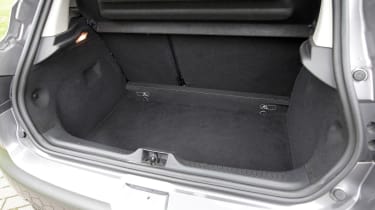Used Renault Clio (Mk4, 2012-2019) - How practical is it?
Sleeker looks mask a wheelbase stretch and a class-leading boot – but the Clio is still cramped in the back
Interior space was maximised for the fourth-generation Clio, despite striking looks and exterior dimensions only slightly bigger than those of the previous model. It's still not as good as the best in class, however.
Renault provided the Clio with plenty of storage space around the cabin, but the tiny glovebox barely fits the owner's manual in it. There are cubby holes in front of the gearlever, centre armrest and door panels.
The user-friendly interior has all functions within easy reach of the driver, although the location of some controls is less than intuitive. The starter button is on the wrong side, and the switch for the cruise control and speed limiter is oddly located by the handbrake.
Visibility out the front is fine, but the thick rear pillar can make over-the-shoulder vision tricky when reversing.
Dimensions and cabin design
With an extra 30mm over its predecessor, the Clio stretched its size advantage over rivals to the point where it’s one of the biggest in the supermini class.
Renault also tweaked the suspension to make the car 45mm lower, while the platform was modified to produce a slightly longer wheelbase and wider track than the outgoing car. There's also a good-sized boot, but there's several superminis that are more accommodating for back-seat passengers.
Used - available now
The Clio has less space for rear passengers than the Ford Fiesta due to its low roofline, small side windows and high-mounted rear bench, which can make it feel cramped and narrow for taller passengers. However, given the Clio is only offered as a five-door, getting in and out of the back seats is easy.
There are three fixed-point seatbelts in the rear, but fitting three passengers in the car will be a squash. Up front, the driver and passenger do better, because accommodation is more than acceptable.
Boot space
Boot space is larger than that of key rivals. At 300 litres, it beats the capacities of the Fiesta and Peugeot 208, which offer 292 and 285 litres respectively.
When the rear seats are folded flat, the load area expands to 1,146 litres and a 60:40 split enables larger loads to be carried with ease. There’s a 1,200kg maximum braked towing limit on all models.
Equipment and technology
Despite a comprehensive standard equipment list, many of the interior plastics on the dash and doors feel scratchy and cheap – the manual air-conditioning dials and air vents are particularly flimsy. Renault claims it made big improvements to this in 2016, but to our eyes (and touch) it was only marginally better.
Following a simplification of the range in 2018, there were just three trim levels to choose from: Play, Iconic and GT-Line.
Play is the entry point and comes as standard with 16-inch alloy wheels, manual air-conditioning, keyless entry, front foglights, cruise control with a speed limiter, electrically adjustable and heated door mirrors, plus an infotainment system with Renault’s R&Go smartphone connectivity app and DAB radio.
The step up to Iconic trim adds 17-inch alloys, a fully fledged seven-inch infotainment system with sat-nav and an uprated sound system, rear parking sensors, plus rear privacy glass. Android Auto and Apple CarPlay connectivity is also added. GT Line sits at the top of the range and adds LED headlights, climate control, automatic headlights and wipers and electrically folding mirrors.
While each Clio trim comes well equipped as standard, there were some option packs that could be added to Iconic and GT-Line models only. The £300 convenience pack on Iconic models and above added automatic climate control, electric rear windows and automatic headlights and wipers.
The Techno Pack Bose Premium package, which adds a premium Bose stereo along with a hands-free parking and side protection system, was available on top-spec GT-Line models only priced at £1,200. GT-Line cars could also be specified with a £100 visibility pack including LED interior lighting and an ‘electrochrome’ rear-view mirror.
The basic Clio radio unit features a built-in display with USB and Bluetooth connectivity, so you can stream your own music and talk hands-free on the phone. For the facelift, a smartphone mount on top of the dashboard has been drafted in from the Twingo, which connects to the speakers to allow audio and navigation instructions to be pumped through them. This also makes sat-nav available on all models – kind of. On the Clio Play, the nav comes in the form of Renault’s free R&GO smartphone app.
Yet for all its high spec, the navigation and menu interfaces are not as slick as they are in the best rival systems. Whichever you pick, it can also be upgraded with a subwoofer, although this has an unfortunate tendency to make the door trim rattle.
Safety
The Clio continued Renault's impressive record, and earned a full five-star Euro NCAP rating in 2012. It wouldn't get five stars today, because it doesn't have city braking on offer, but with 89 per cent for adult occupant protection and an impressive 99 per cent score in the safety assist category, it's still a good performer.
Renault fitted ESP, ABS and Emergency Brake Assist as standard to all of its Clios, as well as a full complement of airbags. Rear parking sensors and a reversing camera were also available as options.












